Research and Design of the RF Cavity for an 11 MeV Superconducting Cyclotron
Abstract
:Featured Application
Abstract
1. Introduction
2. Miniaturization of RF Cavity for an 11 MeV Superconducting Cyclotron
2.1. Structure of the Cyclotron’s RF Cavity Using the Stepped Impedance Resonator (SIR) Approach
2.2. Effects of Discontinuity
3. Equivalent Circuit of the RF Cavity
3.1. Equivalent Circuit Model of RF Cavity
3.2. Determination of Equivalent Circuit Parameters
4. Design and Simulation of the RF Cavity
4.1. Design of the RF Cavity
4.2. Structural Analysis of the RF Cavities
4.3. Optimized Design of the RF Cavity
4.4. Numerical Calculation of Electromagnetic Fields of the RF Cavity
5. Calculation and Verification of the RF Cavity for 11 MeV Superconducting Cyclotrons
5.1. Calculation and Verification of the RF Cavity with Different Structural Parameters
5.2. Analysis of the RF Cavity Based on Multiple Linear Regression Models
6. Conclusions
Author Contributions
Funding
Institutional Review Board Statement
Informed Consent Statement
Data Availability Statement
Acknowledgments
Conflicts of Interest
References
- Qaim, S.M. The present and future of medical radionuclide production. Radiochim. Acta 2012, 100, 635–651. [Google Scholar] [CrossRef]
- Qaim, S.M.; Spahn, I. Development of novel radionuclides for medical applications. Label. Compd. Radiopharm. 2018, 61, 126–140. [Google Scholar] [CrossRef] [PubMed]
- Schmor, P.W.; Vancouver, B.C. Review of cyclotrons for the production of radioactive isotopes for medical and industrial applications. Rev. Accel. Sci. Technol. 2011, 4, 103–116. [Google Scholar] [CrossRef]
- Qaim, S.M. Nuclear data for medical radionuclides. J. Radioanal. Nucl. Chem. 2015, 305, 233–245. [Google Scholar] [CrossRef]
- Synowiecki, M.A.; Perk, L.R.; Nijsen, J.F.W. Production of novel diagnostic radionuclides in small medical cyclotrons. EJNMMI Radiopharm. Chem. 2018, 3, 3. [Google Scholar] [CrossRef] [PubMed]
- McQuade, P.; Rowland, D.J.; Lewis, J.S.; Welch, M.J. Positron-emitting isotopes produced on biomedical cyclotrons. Curr. Med. Chem. 2005, 12, 807–818. [Google Scholar] [CrossRef] [PubMed]
- Gavela, D.; Calero, J.; García-Tabarés, L.; Guirao, A.; Obradors-Campos, D.; Oliver, C.; Pérez, J.M. Calculation and design of a RF cavity for a novel compact superconducting cyclotron for radioisotope production (AMIT). In Proceedings of the International Particle Accelerator Conference (6th), Richmond, VA, USA, 3–8 May 2015; pp. 3055–3057. [Google Scholar]
- Smirnov, V.; Vorozhtsov, S. Modern compact accelerators of cyclotron type for medical applications. Phys. Part. Nucl. 2016, 47, 863–883. [Google Scholar] [CrossRef]
- Munilla, J. Compact accelerators for radioisotope production: The AMIT project. In Proceedings of the Academia-Industry Event on Superconductivity for Accelerators for Medical Applications, Madrid, Spain, 24–25 November 2016. [Google Scholar]
- Makimoto, M.; Yamashita, S. Quarter-Wavelength-Type SIR. In Microwave Resonators and Filters for Wireless Communication: Theory, Design and Application; Springer Series in Advanced Microelectronics; Springer: Berlin/Heidelberg, Germany, 2001; Volume 4, pp. 19–39. [Google Scholar]
- RF Module Users Guide, COMSOL 5.3; COMSOL AB: Stockholm, Sweden, 2018; pp. 77–172.
- Dong, T.L.; Zhan, L.M.; Hong, Y.M.; Fan, M.W. Cyclotron cavity analysis based on field circuit model. Nucl. Instrum. Methods Phys. Res. Sect. A Accel. Spectrometers Detect. Assoc. Equip. 2003, 513, 631–634. [Google Scholar] [CrossRef]
- Zhan, L.M.; Hong, Y.M.; Dong, T.L. Application of two-dimensional boundary element method to resonant frequency problem of accelerator cavity. At. Energy Sci. 2004, 38, 10. [Google Scholar]
- Benedicto, J.; Aouidad, M.H.; Rius, E.; Favennec, J.F.; Annaig, M.G.; Manchec, A. Analytical modeling of three-section coaxial stepped impedance resonators for the design of compact Tx bandpass filters. IEEE Trans. Microw. Theory Tech. 2022, 70, 4140–4155. [Google Scholar] [CrossRef]
- Benedicto, J.; Rius, E.; Bonizec, A.; Favennec, J.F.; Bernal, A.B.; Annaig, M.G. Quarter-Wavelength and Open-End Half-Wavelength Four-Section Coaxial Stepped Impedance Resonators for High-Power Space Bandpass Filters. IEEE Trans. Microw. Theory Tech. 2023. [Google Scholar] [CrossRef]
- Pozar, D.M. Transmission Line Theory. In Microwave Engineering; Wiley: Hoboken, NJ, USA, 2011; pp. 48–95. [Google Scholar]
- Srivastava, G.P.; Gupta, V.L. Microwave Transmission Lines. In Microwave Devices and Circuit Design; Prentice-Hall of India Private Limited: New Delhi, India, 2006; pp. 62–101. [Google Scholar]
- Wang, X.; Deslandes, D.; Feng, W.; Chen, H.; Che, W. Coupling analysis of adjacent substrate-integrated waveguides based on the equivalent transmission line model. IEEE Trans. Microw. Theory Tech. 2020, 68, 1347–1354. [Google Scholar] [CrossRef]
- Mohamadian, M.; Afarideh, H.; Ghergherehchi, M. Accurate electromagnetic simulation and design of cyclotron cavity. IEEE Trans. Nucl. Sci. 2016, 64, 809–815. [Google Scholar] [CrossRef]
- Wadell, B.C. Physical Transmission Lines. In Transmission Line Design Handbook; Artech House Microwave Library: Norwood, MA, USA, 1991; pp. 45–177. [Google Scholar]
- Genderen, W.V.; Van Der Heide, J.A.; Bräutigam, W. Calculation of cyclotron rf systems. Nucl. Instrum. Methods Phys. Res. Sect. A Accel. Spectrometers Detect. Assoc. Equip. 1987, 258, 161–169. [Google Scholar] [CrossRef]
- Lee, J.; Ghergherehchi, M.; Shin, S.W.; Kim, H.; Ha, D.; Namgoong, H.; Song, H.S.; Chai, J.S. Design of 83.2 MHz RF cavity for SKKUCY-10 cyclotron. Nucl. Instrum. Methods Phys. Res. Sect. A Accel. Spectrometers Detect. Assoc. Equip. 2019, 939, 66–73. [Google Scholar] [CrossRef]
- Shin, S.; Lee, J.; Lee, B.N.; Ha, D.; Namgoong, H.; Chai, J. Development of the RF cavity for the SKKUCY-9 compact cyclotron. Nucl. Instrum. Methods Phys. Res. Sect. A Accel. Spectrometers Detect. Assoc. Equip. 2015, 795, 276–283. [Google Scholar] [CrossRef]
- Jung, I.S.; An, D.H.; Chai, J.S.; Chang, H.S.; Hong, B.H.; Hur, M.G.; Kang, J.; Kim, S.W.; Kim, Y.S.; Chong, S.P.; et al. Design of KIRAMS-13 RF system for regional cyclotron center. In Proceedings of the 2004 Autumn Meeting of the KNS, Yongpyong, Republic of Korea, 28–29 October 2004; pp. 353–355. [Google Scholar]
- Kim, Y.S.; An, D.H.; Chai, J.S.; Chang, H.S.; Hong, B.H.; Hong, S.S.; Hur, M.G.; Hwang, W.T.; Jung, I.S.; Kang, J.S. New Design of the KIRAMS-13 cyclotron for regional cyclotron center. In Proceedings of the 3rd Asian Particle Accelerator Conference, Gyenogiu, Republic of Korea, 22–26 May 2004; pp. 338–340. [Google Scholar]
- Korkmaz, M. A study over the formulation of the parameters 5 or less independent variables of multiple linear regression. J. Funct. Spaces 2019, 2019, 1526920. [Google Scholar] [CrossRef]
- Chicco, D.; Warrens, M.J.; Jurman, G. The coefficient of determination R-squared is more informative than SMAPE, MAE, MAPE, MSE and RMSE in regression analysis evaluation. PeerJ Comput. Sci. 2021, 7, e623. [Google Scholar] [CrossRef] [PubMed]
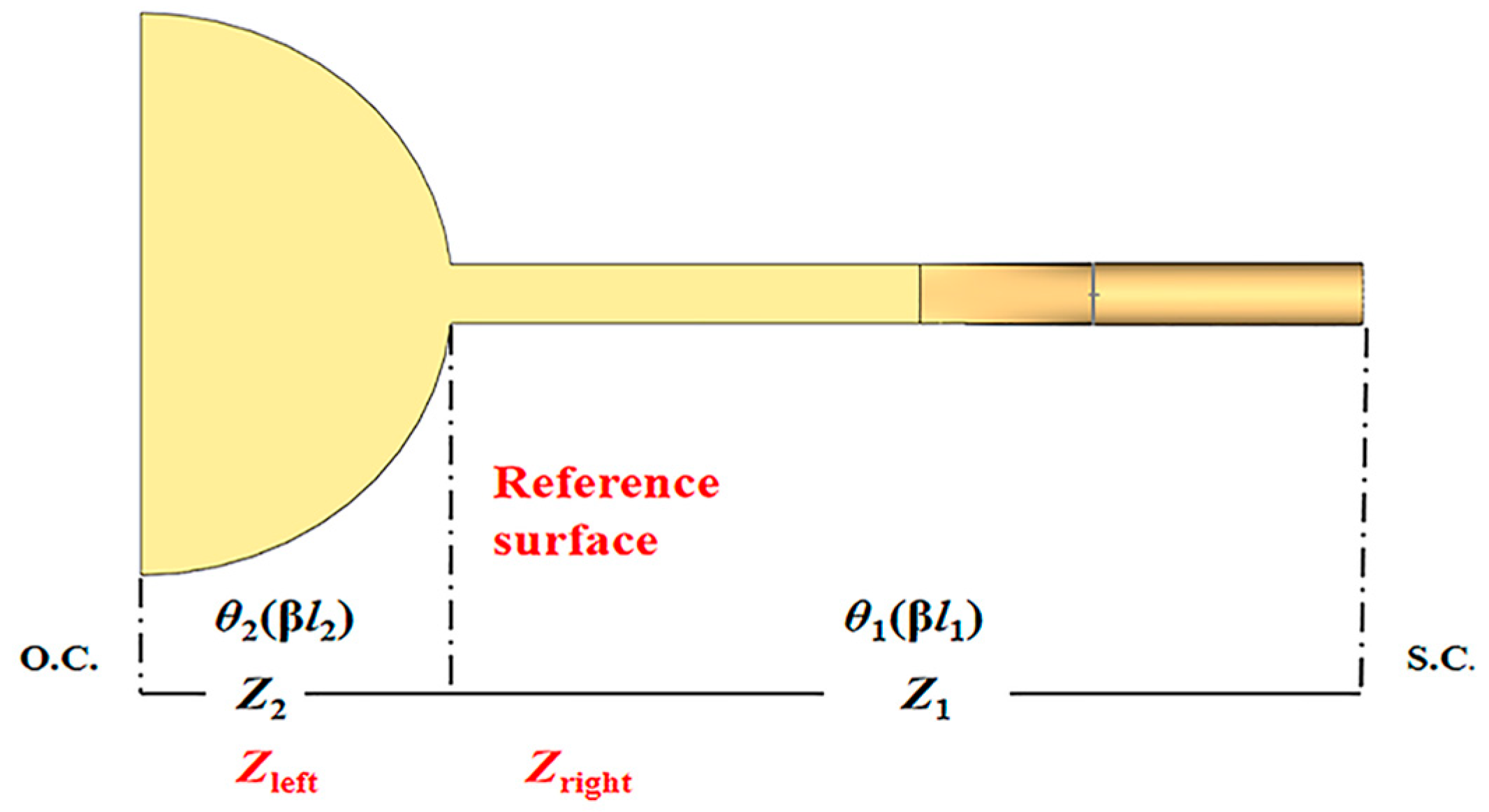
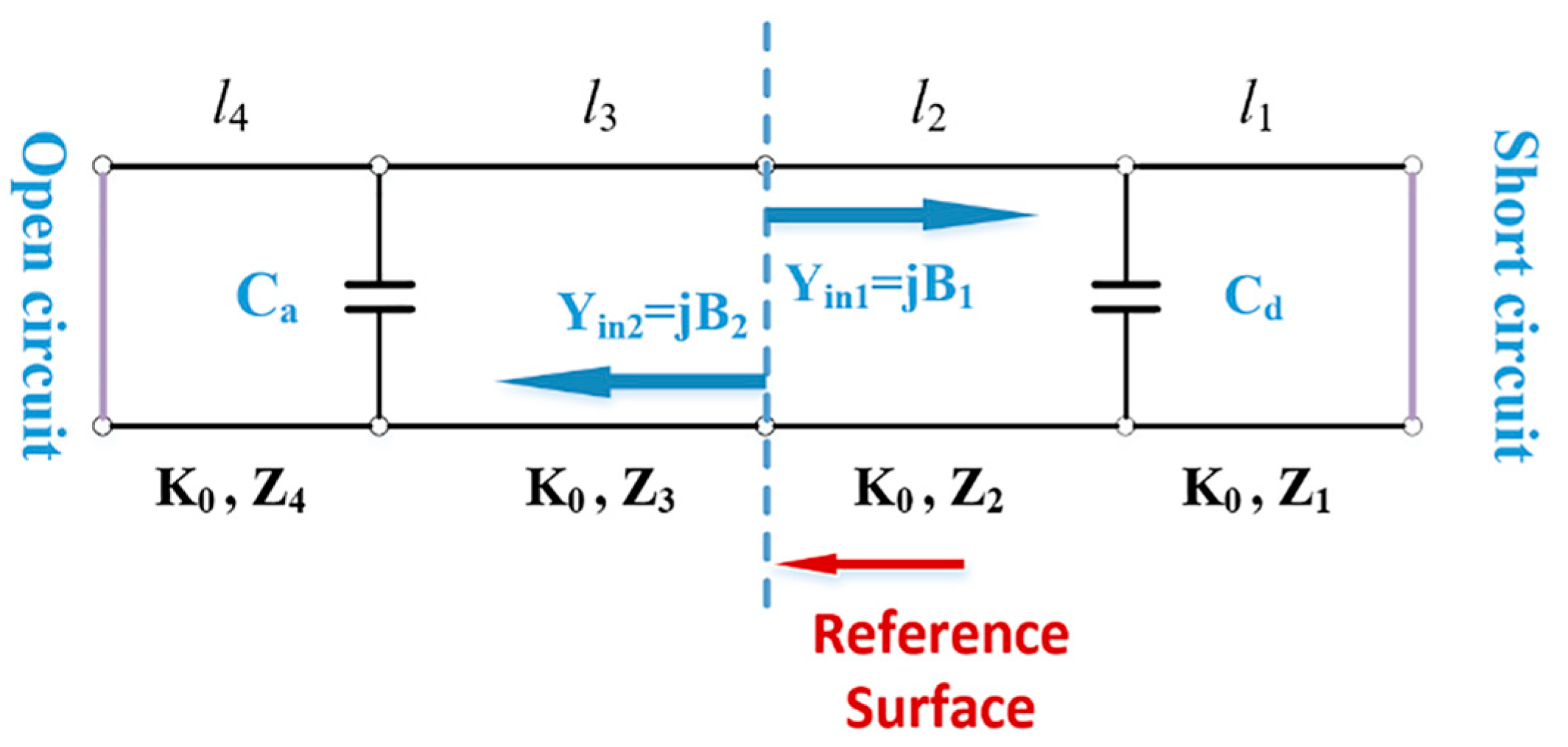
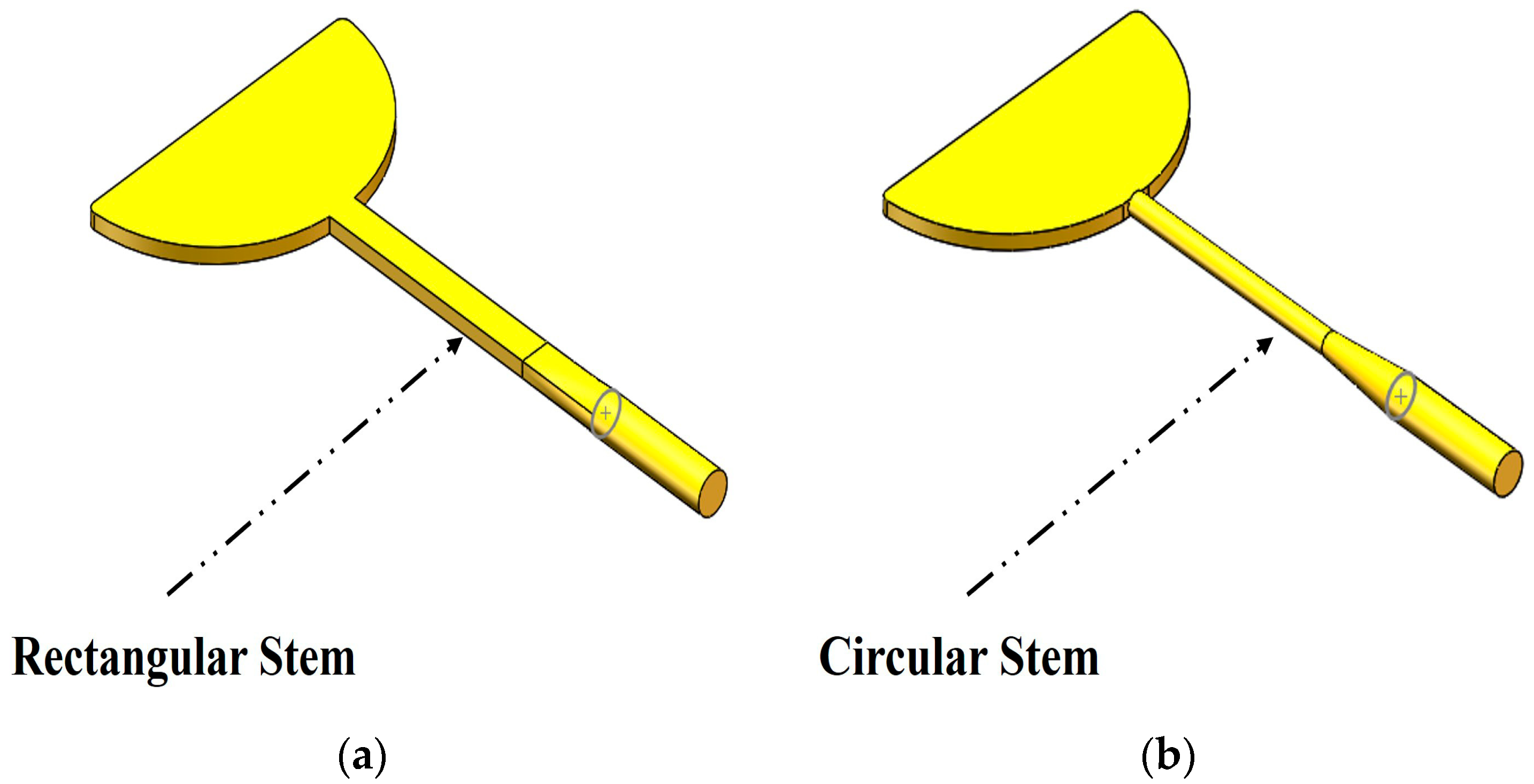
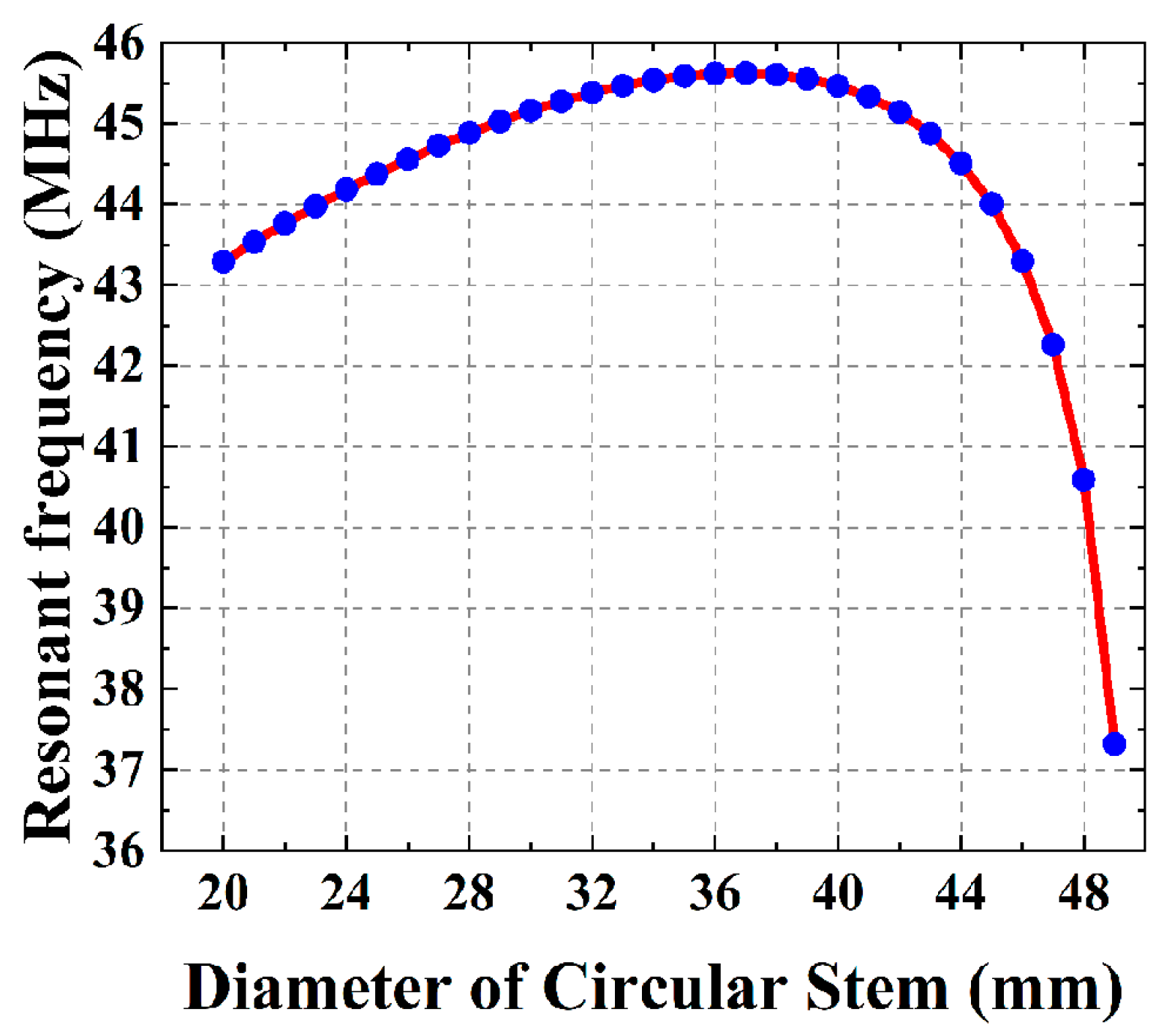

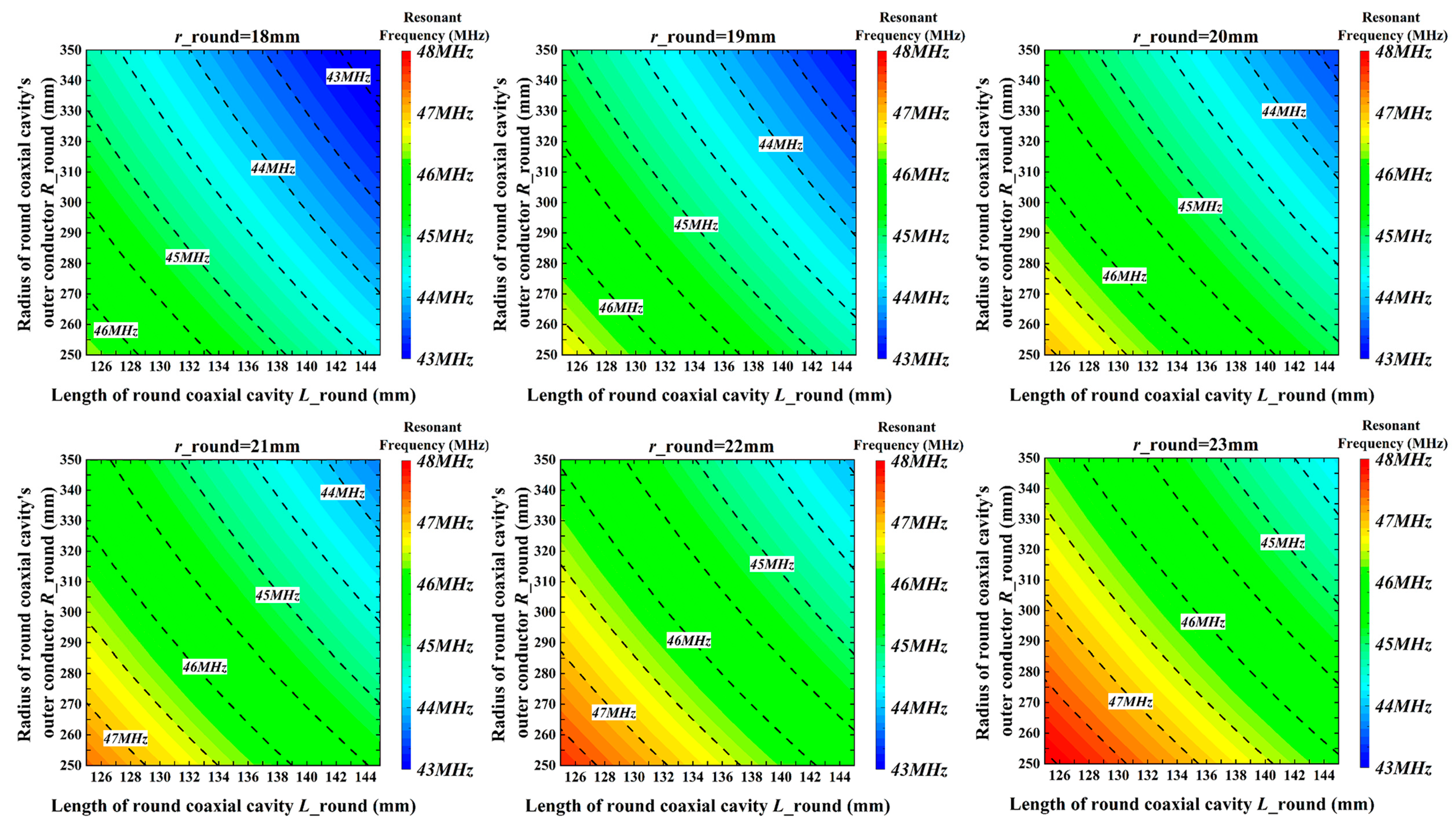
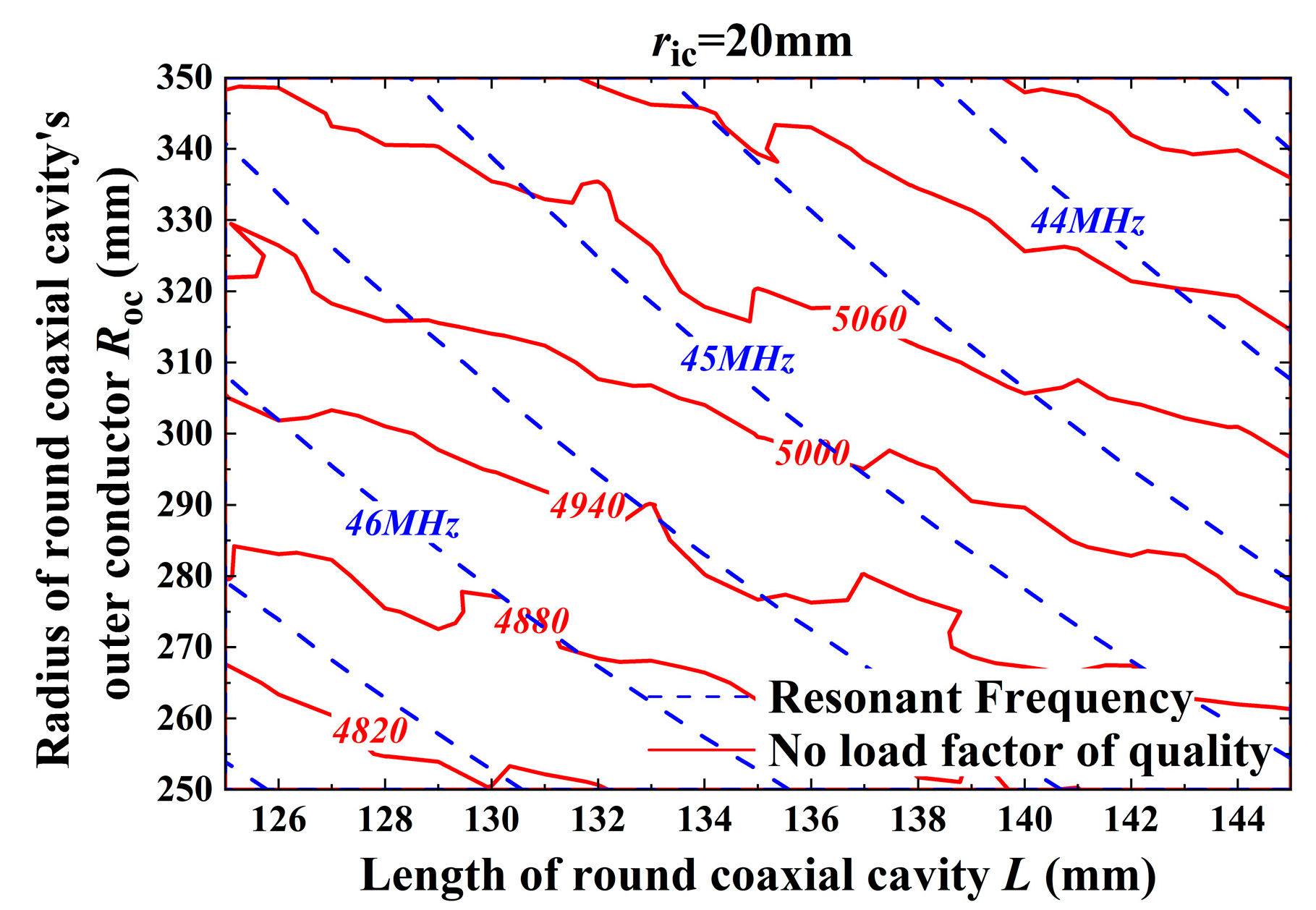
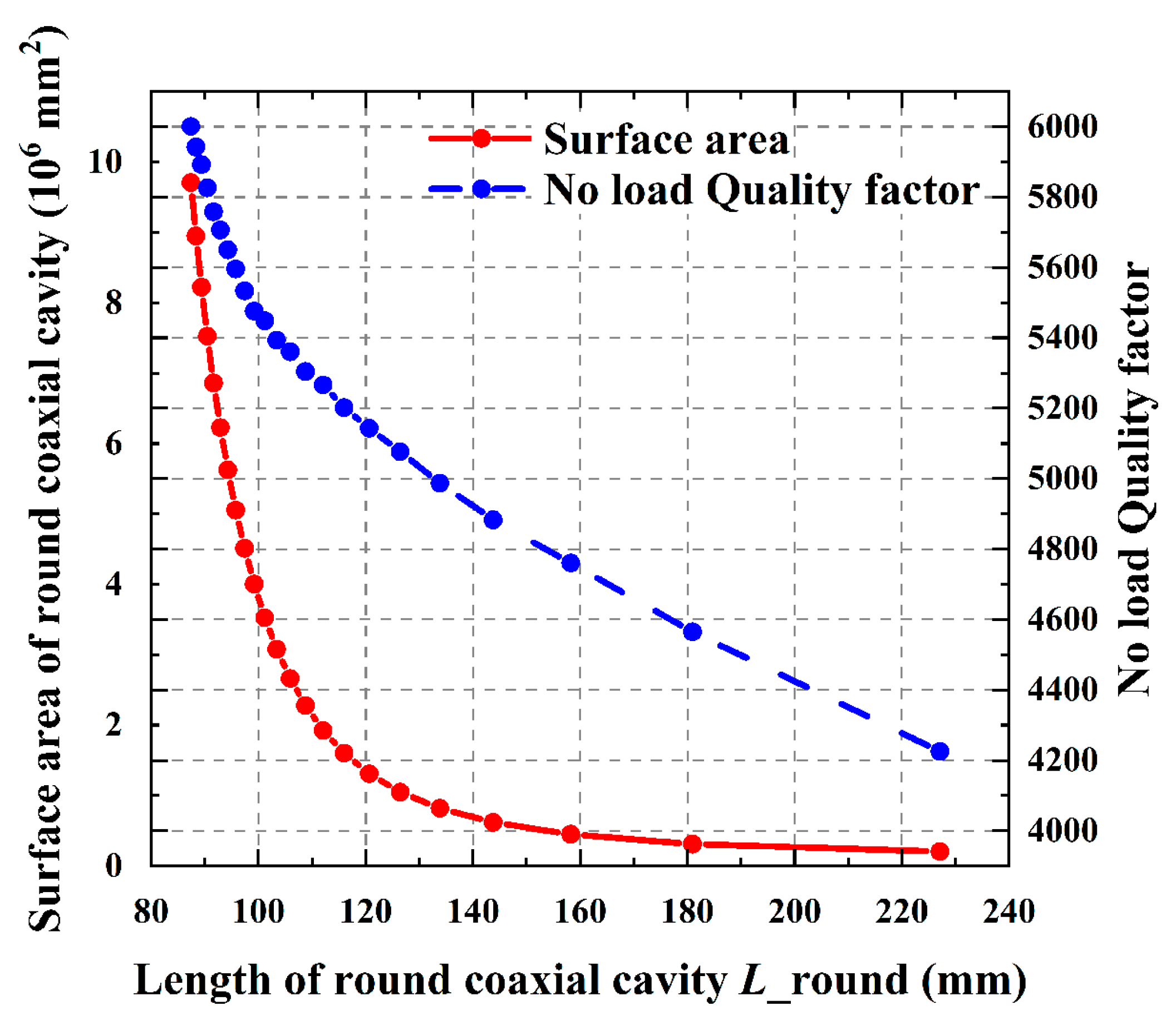

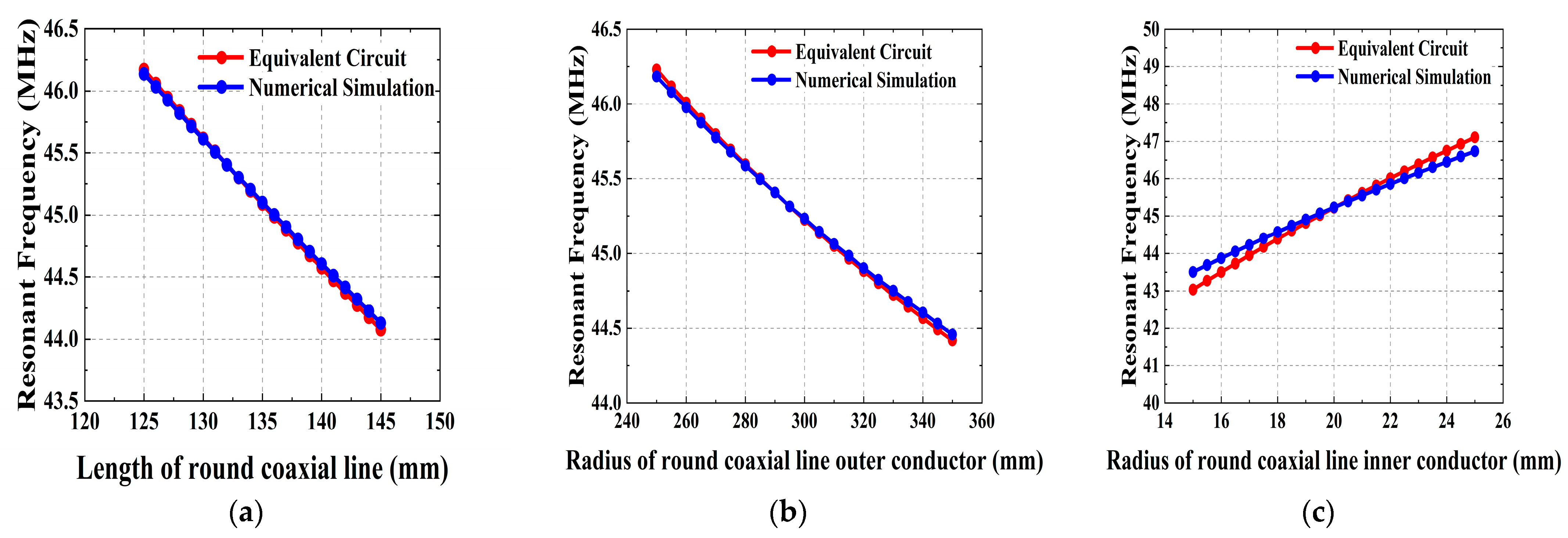
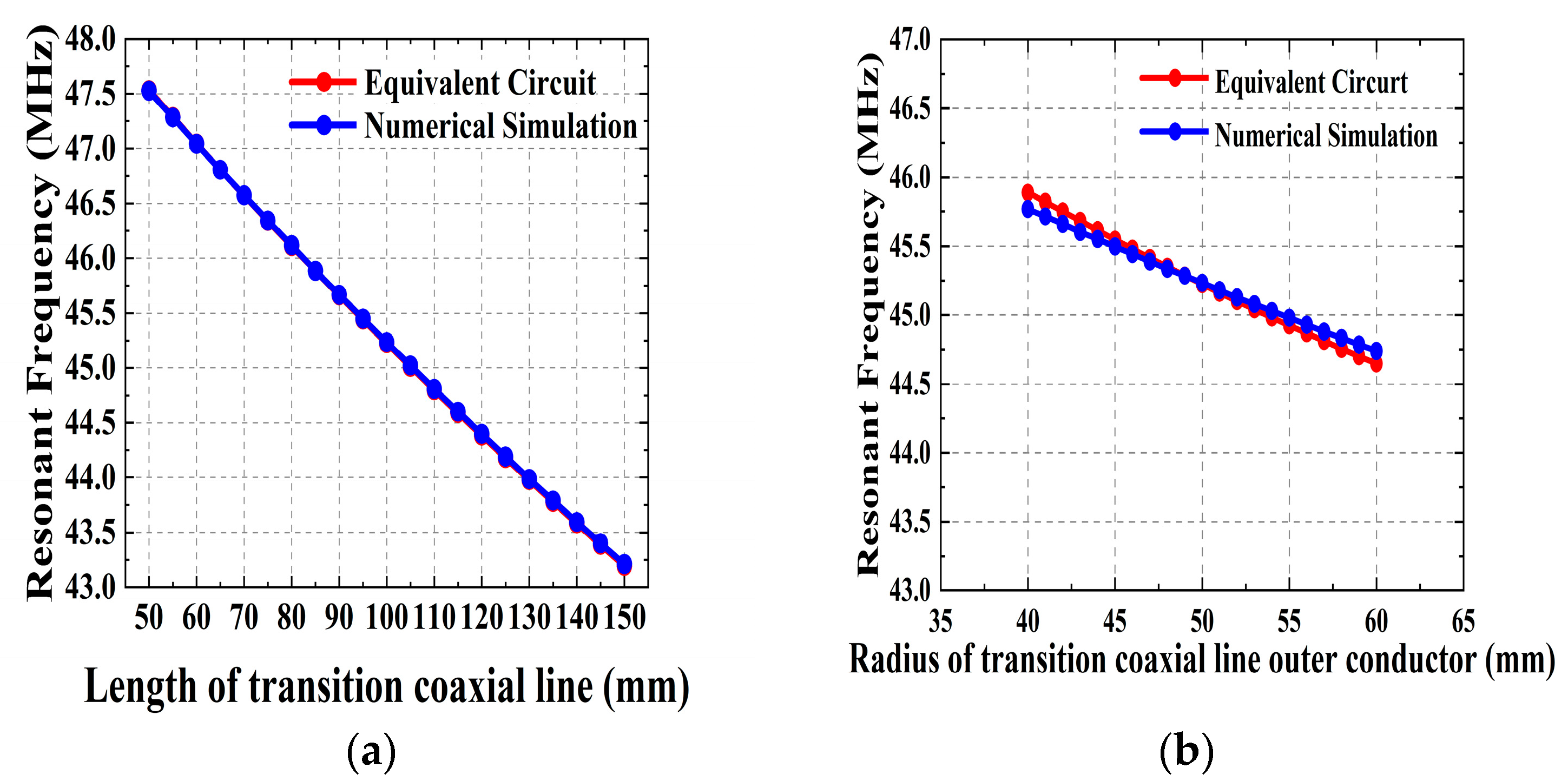
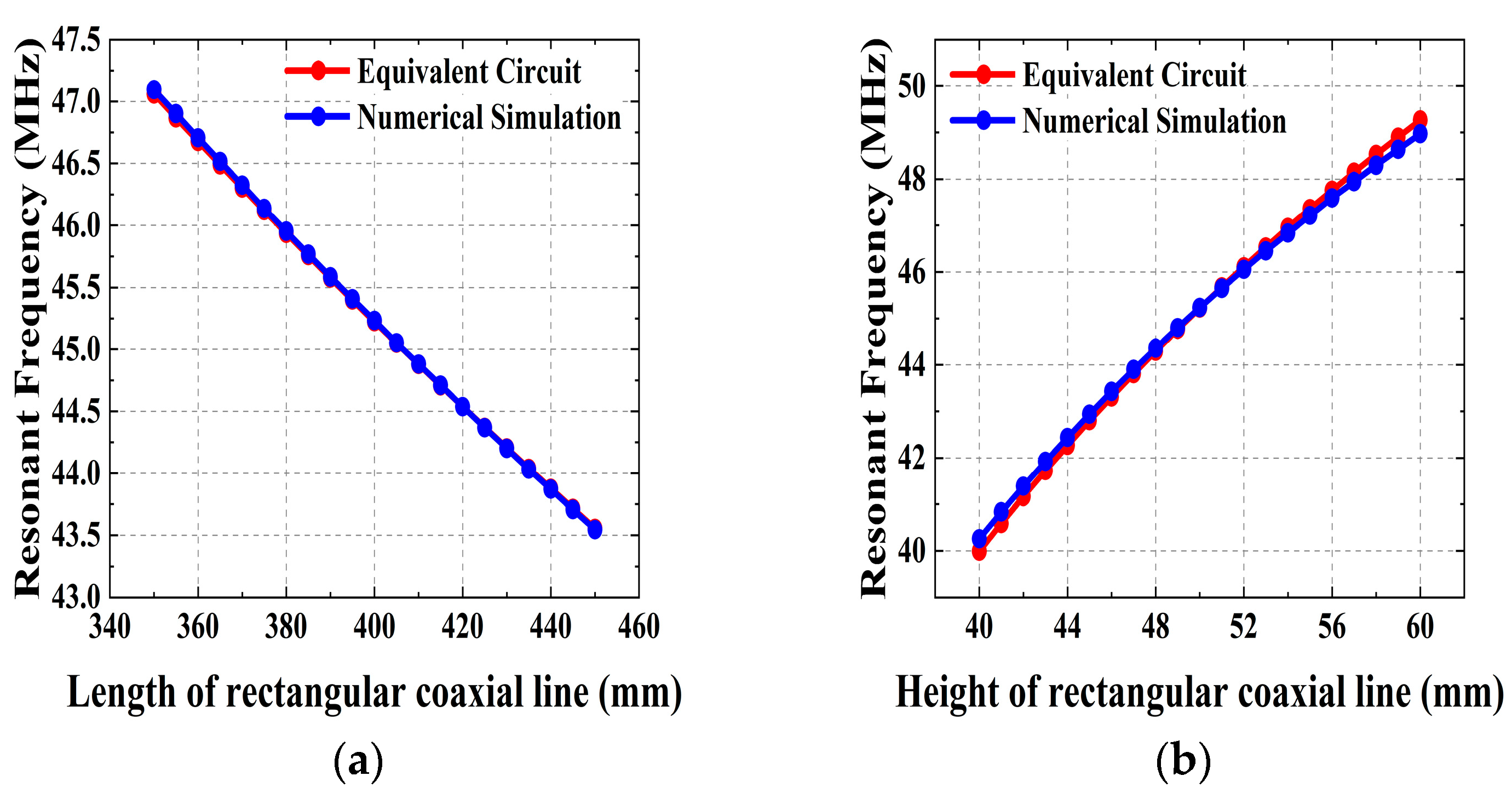

| Cyclotron Parameters | Value |
|---|---|
| Energy | 11 MeV |
| Resonant Frequency | 45.026 MHz |
| Harmonic No. | 1 |
| Extraction Radius | 161 mm |
| Dee Voltage | 30 kV |
| Coupling Type | Inductive |
| Method | RMSE | R2 | Regression Equation |
|---|---|---|---|
| Numerical simulation | 0.040 | 0.998 | f = 57.573 + 0.3172 × ric − 0.0174 × roc − 0.1005 × L |
| Equivalent circuit | 0.052 | 0.998 | f = 56.856 + 0.3995 × ric − 0.0183 × roc − 0.1054 × L |
Disclaimer/Publisher’s Note: The statements, opinions and data contained in all publications are solely those of the individual author(s) and contributor(s) and not of MDPI and/or the editor(s). MDPI and/or the editor(s) disclaim responsibility for any injury to people or property resulting from any ideas, methods, instructions or products referred to in the content. |
© 2024 by the authors. Licensee MDPI, Basel, Switzerland. This article is an open access article distributed under the terms and conditions of the Creative Commons Attribution (CC BY) license (https://creativecommons.org/licenses/by/4.0/).
Share and Cite
Wu, Y.; He, Z.-F.; Wan, W.-S.; Zheng, P.-P.; Yu, H.-F. Research and Design of the RF Cavity for an 11 MeV Superconducting Cyclotron. Appl. Sci. 2024, 14, 3549. https://doi.org/10.3390/app14093549
Wu Y, He Z-F, Wan W-S, Zheng P-P, Yu H-F. Research and Design of the RF Cavity for an 11 MeV Superconducting Cyclotron. Applied Sciences. 2024; 14(9):3549. https://doi.org/10.3390/app14093549
Chicago/Turabian StyleWu, Yue, Zi-Feng He, Wei-Shi Wan, Pan-Pan Zheng, and Hua-Fei Yu. 2024. "Research and Design of the RF Cavity for an 11 MeV Superconducting Cyclotron" Applied Sciences 14, no. 9: 3549. https://doi.org/10.3390/app14093549





